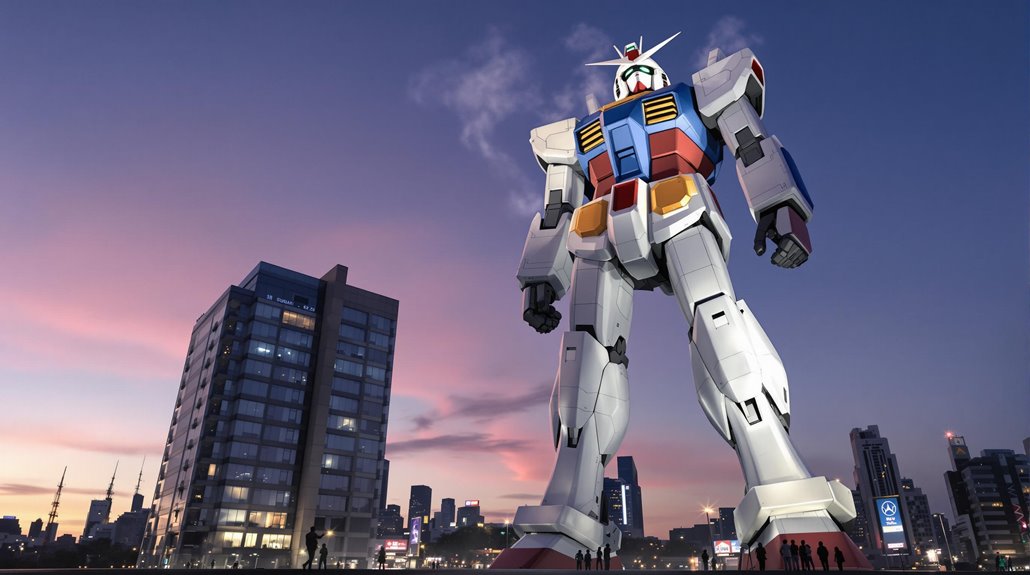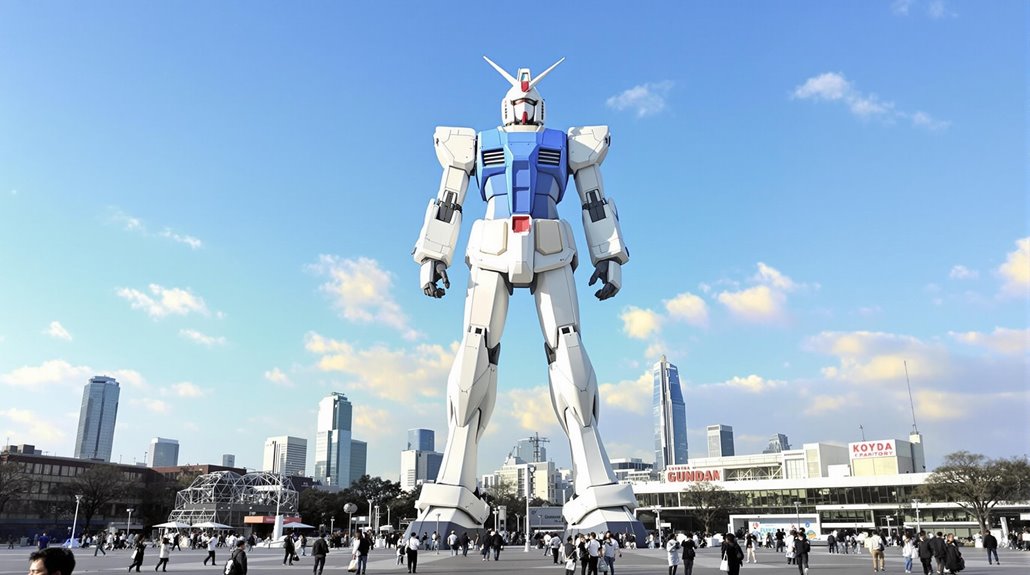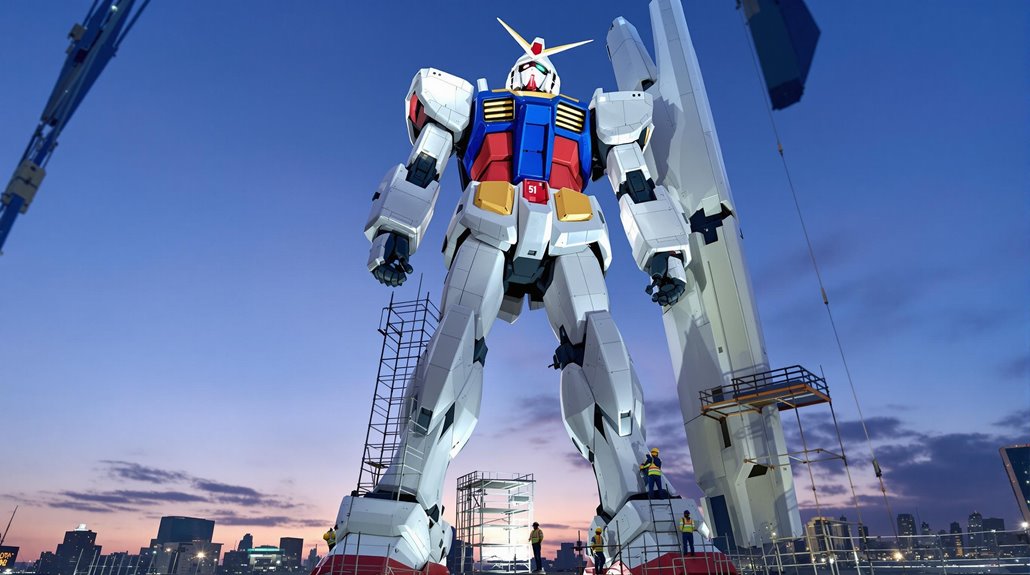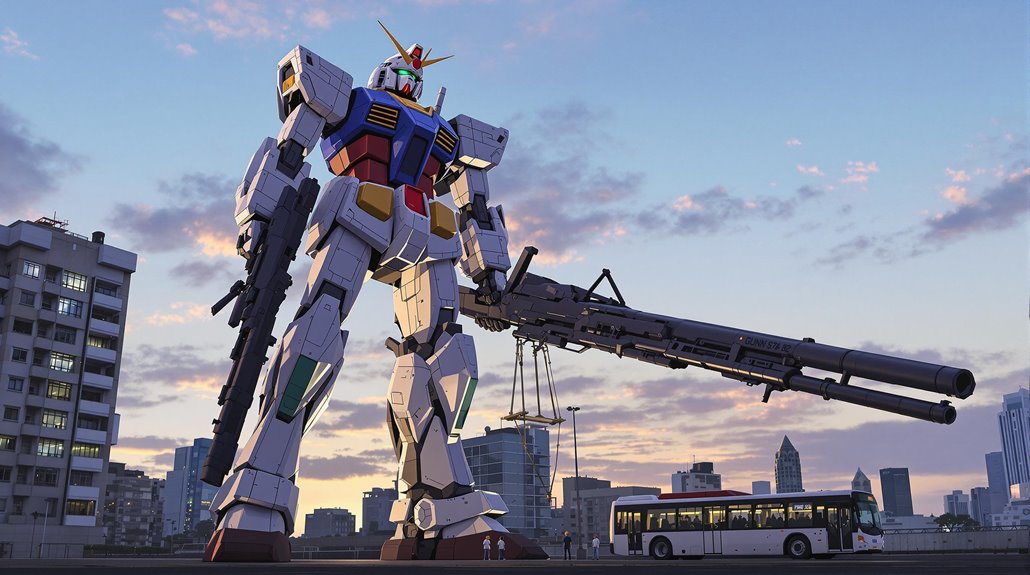How Big Is a Gundam?

Gundams are massive mobile suits that typically stand between 59-81 feet tall (18-25 meters), with variations across different models and series. You'll find the classic RX-78-2 reaching 59 feet, while the Unicorn Gundam extends to 71 feet in Destroy Mode. The largest real-world example is the RX-93 Nu Gundam statue in Fukuoka at 81.5 feet. These incredible heights help explain why these mechanical warriors dominate both cityscapes and battlefields.
Comparing Real-World Scale Models and Statues

The most iconic real-world Gundam statues tower over visitors throughout Japan, with heights ranging from 59 to 81.5 feet tall. You'll find the classic RX-78-2 mobile suit Gundam standing at 59 feet in Odaiba, while its successor, the Unicorn Gundam, reaches 71 feet when converted into Destroy Mode.
The moving scale Gundam at Gundam Factory Yokohama matches the original RX-78-2's height at 60 feet, offering visitors a glimpse of how these massive machines would function in reality. Bandai's newest addition, the RX-93 Nu Gundam in Fukuoka, claims the title of largest Gundam model ever constructed at a staggering 81.5 feet tall. These life-sized statues help fans truly grasp the immense scale of their favorite mobile suits. These impressive displays showcase Japan's dedication to realistic mecha designs that revolutionized the robot anime genre in 1979.
Evolution of Gundam Heights Across Series
While real-world Gundam statues amaze visitors with their towering presence, these monuments reflect a carefully planned transition in mobile suit design across different anime series.
You'll notice that the original Gundam RX-78-2 established a baseline height of 18 meters for the franchise, but later designs grew taller. The RX-0 Unicorn Gundam represents this evolution perfectly, as it stands slightly taller at 19.7 meters in its standard form and extends to 21.7 meters when converted into Destroy mode.
This gradual increase in size continues with modern designs, exemplified by the upcoming RX-93 Nu Gundam statue in Fukuoka. At 24.8 meters, it'll tower over both the Life-Sized Gundam in Yokohama and the Unicorn Gundam in Odaiba, showcasing how mobile suit proportions have grown over time.
The evolution of these massive mobile suits has been faithfully captured in Bandai's model kits since their first release in 1980.
Technical Specifications of Famous Mobile Suits

Understanding mobile suit specifications starts with their impressive dimensions. You'll find the classic RX-78-2 Gundam, the original Mobile Suit that launched the Gundam series, standing at a commanding 18 meters tall at Divinity Plaza.
The Gundam Unicorn takes this scale even further, with its Destroy Mode reaching 21.7 meters and its Unicorn Mode measuring 19.7 meters at the Odaiba base.
Looking ahead, the RX-93 Nu Gundam in Fukuoka will set a new record at 24.8 meters. When it comes to scale models, however, the dimensions are more modest. The Perfect Zeong tops the Gunpla line at 36 centimeters, while the HGUC Dendrobium stands as the tallest standard Gunpla at 17.8 centimeters without modifications.
The Turn A Gundam features a distinctive hollow chest that houses a man-made black hole for storage purposes.
Notable Size Differences Between Mobile Suit Classes
Mobile suit classes showcase dramatic size variations across different timelines and universes. You'll find standard Mobile suits like the Zaku measuring around 15 meters, while specialized Gundam units can tower much higher. The Universal Century timeline features some of the most diverse size ranges, from basic units to the massive RX-0 Unicorn Gundam at 60 meters.
- Standard mobile suits typically range from 15-18 meters, similar to a five-story building
- Gundam-type units generally stand taller, averaging 18-25 meters
- Mobile armors represent the largest class, with behemoths like the Neo Zeong reaching 60 meters
- Cosmic Era mobile suits tend to be more compact, rarely exceeding 18 meters
These varying dimensions help you understand why a real-life Gundam statue makes such an impressive sight at its true-to-scale height.
Engineering Challenges of Life-Sized Gundams

Creating a life-sized Gundam presents complex engineering obstacles that go far beyond simple scaling. Unlike building model kits, constructing a mega size Gundam requires precise calculations to maintain structural integrity while supporting massive weight across its humanoid frame.
The proportions that look perfect on a model kit become exponentially more difficult to achieve when translated to real-world materials and physics. They need to carefully design support systems that can handle the statue's enormous mass while allowing for movement in specific parts.
You'll find that the engineering team must solve critical challenges in power distribution, mechanical articulation, and weather resistance. Additionally, you'll need to ponder how to protect the completed structure from environmental factors and implement reliable maintenance solutions to preserve its functionality and appearance long-term.
Historic Landmarks in Gundam Construction
The construction of full-scale Gundam statues represents major milestones in bringing anime's most iconic mecha to life. From the original RX-78-2 Gundam in 2009 to the upcoming Nu Gundam in Fukuoka, you'll find these towering monuments pushing engineering boundaries. Each statue requires careful attention to detail, just like applying a water slide decal to a model kit, but on a massive scale.
- The RX-78-2 in Yokohama kickstarted the era of life-sized Universal Century mobile suits.
- Unicorn Gundam (Destroy Mode) in Tokyo reaches an impressive 21.7m when changed.
- Shanghai's Freedom Gundam marks the first full-scale statue outside Japan.
- Fukuoka's Nu Gundam will set a new height record at 24.8m.
These landmarks continue to inspire fans and showcase Japan's engineering prowess in bringing fiction to reality.
Size Impact on Combat Performance

Scale plays a vital role in determining a Gundam's combat effectiveness. You'll find that larger units like the MSN-00100 Hyaku Shiki pack devastating firepower but face mobility challenges, much like the units displayed at East Shizuoka Square. The original Mobile Suit RX-78-2, featured in the first Gundam anime series, represents the ideal 18-meter height that balances combat capability with resource efficiency.
While massive models like the 24.8-meter RX-93 νGundam can dominate battlefields through sheer size, they're often hindered in tight spaces. Conversely, compact units like the 5-meter RB-79 Ball offer superior agility but sacrifice combat potential. You'll notice this size-performance relationship remains a central factor in Gundam design, where engineers must carefully weigh firepower and armor against mobility and resource costs.
Scale Variations in Gunpla Model Lines
When diving into Gunpla collecting, you'll encounter several distinct model scales that dramatically affect the final size of your build. The popular 1/144 HG line still stands as the most accessible entry point, though some of the largest kits ever built come from this scale, like the massive Dendrobium and Neo Zeong.
A 1/100 MG model would typically be much larger than its HG counterpart, with the Perfect Zeong and EX-S Gundam leading the size charts.
- Higher grades (PG 1/60) offer increased size and detail
- Additional accessories expand the model's footprint
- Famous Mobile Suits often receive Mega Size versions
- Final dimensions depend on the original anime proportions
Price often correlates with size, as larger kits contain more parts and require more materials to produce.


